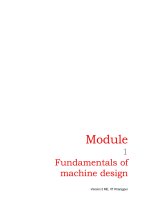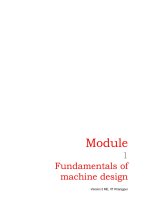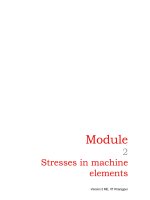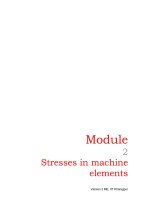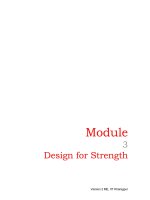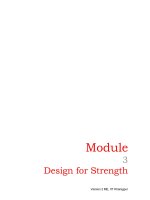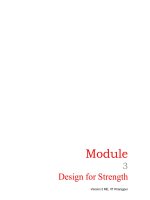Tài liệu Fundamentals of Machine Design P25 docx
Bạn đang xem bản rút gọn của tài liệu. Xem và tải ngay bản đầy đủ của tài liệu tại đây (178.61 KB, 14 trang )
Module
9
Thin and thick
cylinders
Version 2 ME, IIT Kharagpur
Lesson
2
Thick cylinders-
Stresses due to internal
and external pressures.
Version 2 ME, IIT Kharagpur
Instructional Objectives:
At the end of this lesson, the students should have the knowledge of:
• Stresses in thick cylinders.
• Lame’s equation for radial and circumferential stresses.
• Distribution of radial and circumferential stresses for different boundary conditions.
• Methods of increasing elastic strength of thick cylinders by prestressing.
9.2.1 Stresses in thick cylinders
For thick cylinders such as guns, pipes to hydraulic presses, high pressure
hydraulic pipes the wall thickness is relatively large and the stress variation across the
thickness is also significant. In this situation the approach made in the previous section is
not suitable. The problem may be solved by considering an axisymmetry about z-axis and
solving the differential equations of stress equilibrium in polar co-ordinates. In general
the stress equations of equilibrium without body forces can be given as
rr
rrz
rzr
z
zr z zr
1
0
rr z r
1
20
rr z r
1
0
rr z r
θθ
θθθθ
θ
∂τ σ − σ
∂σ ∂τ
+++
∂∂θ∂
∂τ ∂τ ∂τ τ
+++=
∂∂θ∂
∂τ
∂τ ∂σ τ
+++=
∂∂θ∂
=
(1)
For axisymmetry about z-axis
0
∂
=
∂θ
and this gives
r
rrz
rz r
zr z zr
0
rz r
20
rz r
0
rzr
θ
θθ θ
σ−σ
∂σ ∂τ
++ =
∂∂
∂τ ∂τ τ
++ =
∂∂
∂τ ∂σ τ
++=
∂∂
(2)
In a plane stress situation if the cylinder ends are free to expand σ
z
= 0 and due to
uniform radial deformation and symmetry τ
rz
= τ
θz
= τ
rθ
= 0. The equation of equilibrium
reduces to
Version 2 ME, IIT Kharagpur
r
r
0
rr
θ
σ−σ
∂σ
+
∂
=
This can be written in the following form:
r
r
r
r
θ
∂σ
+σ =σ
∂
(3)
If we consider a general case with body forces such as centrifugal forces in the case of a
rotating cylinder or disc then the equations reduce to
2
r
r
r0
rr
θ
σ−σ
∂σ
++ρω
∂
= which may be written as
22
r
r
rr
r
θ
∂σ
−σ +σ +ρω =
∂
0
(4)
It is convenient to solve the general equation so that a variety of problems may be solved.
Now as shown in
figure- 9.2.1.1, the strains ε
r
and ε
θ
may be given by
[
r
rr
u
1
rE
θ
∂
ε= = σ−νσ
∂
]
since
z
0
σ
= (5)
()
[]
r
r
r
ru r
u
1
rrE
θ
θ
+Δθ−Δθ
ε= = = σ−νσ
Δθ
(6)
Δθ
A
A
'
B
B
'
r
AA
'
BB
'
u
r
r
r
u
ur
r
∂
+δ
∂
9.2.1.1F- Representation of radial and circumferential strain.
Version 2 ME, IIT Kharagpur
Combining equation (5) and (6) we have
()
()
r
r
rr1
rr
θ
θ
∂σ
∂σ
−ν + +ν σ −σ =
∂∂
0
(7)
Now from equation (4) we may write
2
2
rr
2
r22
rr
r
θ
∂σ
∂σ ∂σ
=++ρ
∂∂
∂
rω and combining this with equation (7) we
may arrive at
()
2
2
rr
2
r33 r
r
r
∂σ ∂σ
+++νρω=
∂
∂
0 (8)
For a non-rotating thick cylinder with internal and external pressures p
i
and p
o
we
substitute ω = 0 in equation (8) and this gives
2
rr
2
r3
r
r
∂σ ∂σ
+=
∂
∂
0 (9)
A typical case is shown in
figure- 9.2.1.2. A standard solution for equation (9) is
σ
r
= c r
n
where c and n are constants. Substituting this in equation (9) and also
combining with equation (3) we have
2
r1
2
2
1
2
c
c
r
c
c
r
θ
σ= +
σ= −
(10)
where c
1
and c
2
are constants.
r
o
r
i
p
o
p
i
9.2.1.2F- A thick cylinder with both external and internal pressure.
Version 2 ME, IIT Kharagpur
Boundary conditions for a thick cylinder with internal and external pressures p
i
and p
o
respectively are:
at r = r
i
σ
r
= -p
i
and at r = r
o
σ
r
= -p
o
The negative signs appear due to the compressive nature of the pressures. This gives
()
22
22
io o i
ii oo
12
22 22
oi oi
rr p p
pr p r
cc
rr rr
−
−
==
−−
The radial stress σ
r
and circumferential stress σ
θ
are now given by
()
()
22
22
io o i
ii oo
r
22 22 2
oi oi
22
22
io o i
ii oo
22 22 2
oi oi
rr p p
pr p r
1
rr rr r
rr p p
pr p r
1
rr rr r
θ
−
−
σ= +
−−
−
−
σ= −
−−
(11)
It is important to remember that if σ
θ
works out to be positive, it is tensile and if it is
negative, it is compressive whereas σ
r
is always compressive irrespective of its sign.
Stress distributions for different conditions may be obtained by simply substituting the
relevant values in equation (11). For example, if p
o
= 0 i.e. there is no external pressure
the radial and circumferential stress reduce to
2
2
o
ii
r
22 2
oi
2
2
o
ii
222
oi
r
pr
1
rr r
r
pr
1
rrr
θ
⎛⎞
⎜⎟
σ= − +
⎜⎟
−
⎝
⎛⎞
⎜⎟
σ= +
⎜⎟
−
⎝⎠
⎠
(12)
The stress distribution within the cylinder wall is shown in
figure- 9.2.1.3.
Version 2 ME, IIT Kharagpur
σ
θ
σ
r
r
o
r
i
p
i
9.2.1.3F- Radial and circumferential stress distribution within the cylinder
wall when only internal pressure acts.
It may be noted that σ
r
+ σ
θ
= constant and hence the deformation in z-direction is
uniform. This means that the cross-section perpendicular to the cylinder axis remains
plane. Hence the deformation in an element cut out by two adjacent cross-sections does
not interfere with the adjacent element. Therefore it is justified to assume a condition of
plane stress for an element in section 9.2.1.
If p
i
= 0 i.e. there is no internal pressure the stresses σ
r
and σ
θ
reduce to
2
2
oo
i
r
222
oi
2
2
oo
i
222
oi
pr
r
1
rrr
pr
r
1
rrr
θ
⎛⎞
⎜⎟
σ= −
⎜⎟
−
⎝⎠
⎛⎞
⎜⎟
σ=− +
⎜⎟
−
⎝⎠
(13)
The stress distributions are shown in
figure-9.2.1.4.
Version 2 ME, IIT Kharagpur
σ
θ
(negative)
σ
r
(negative)
r
o
r
i
p
o
9.2.1.4F- Distribution of radial and circumferential stresses within the
cylinder wall when only external pressure acts.
9.2.2 Methods of increasing the elastic strength of a thick cylinder
by pre-stressing
In thick walled cylinders subjected to internal pressure only it can be seen from equation
(12) that the maximum stresses occur at the inside radius and this can be given by
22
oi
i
22
(max)
rr
i
oi
rr
p
rr
θ
=
+
σ=
−
()
ri
max
rr
i
p
=
σ=−
This means that as p
i
increases σ
θ
may exceed yield stress even when p
i
< σ
yield.
Furthermore, it can be shown that for large internal pressures in thick walled cylinders
the wall thickness is required to be very large. This is shown schematically in
figure-
9.2.2.1. This means that the material near the outer edge is not effectively used since the
stresses near the outer edge gradually reduce (Refer to
figure- 9.2.1.3).
Version 2 ME, IIT Kharagpur
t
p
i
9.2.2.1F- A schematic variation of wall thickness with the internal pressure in
a thick walled cylinder.
In order to make thick-walled cylinders that resist elastically large internal pressure and
make effective use of material at the outer portion of the cylinder the following methods
of pre-stressing are used:
1.
Shrinking a hollow cylinder over the main cylinder.
2.
Multilayered or laminated cylinders.
3.
Autofrettage or self hooping.
1. Composite cylinders
An outer cylinder (jacket) with the internal diameter slightly smaller than
the outer diameter of the main cylinder is heated and fitted onto the main
cylinder. When the assembly cools down to room temperature a composite
cylinder is obtained. In this process the main cylinder is subjected to an
external pressure leading to a compressive radial stress at the interface.
The outer cylinder or the jacket is subjected to an internal pressure leading
to a tensile circumferential stress at the inner wall. Under this condition as
the internal pressure increases the compression in the inner cylinder is first
released and then only the cylinder begins to act in tension. Gun barrels
Version 2 ME, IIT Kharagpur
are normally pre-stressed by hooping since very large internal pressures
are generated.
Here the main problem is to determine the contact pressure p
s
. At the
contact surface the outer radius r
si
of the inner cylinder is slightly larger
than the inside diameter r
so
of the outer cylinder. However for stress
calculations we assume that
so si s
rrr
=
(say). The inner and outer
cylinders are shown in
figure- 9.2.2.2.
Jacket or outer cylinder Inner cylinder
9.2.2.2F- Dimensions and the pressures at the contact surface of the
internal and outer cylinders.
For the
outer cylinder the radial and circumferential stresses at the contact
surface may be given by
22
ss o
rs
22 2
rr
s
os s
22
ss o
22 2
rr
s
os s
pr r
1p
rr r
pr r
1
rr r
=
θ
=
⎛⎞
⎜⎟
σ= −=−
⎜⎟
−
⎝⎠
⎛⎞
⎜⎟
σ= +
⎜⎟
−
⎝⎠
r
si
r
i
p
s
r
so
r
o
p
s
Version 2 ME, IIT Kharagpur
In order to find the radial displacements of the cylinder walls at the
contact we consider that
(
r
u1
rE
θθ
)
ε
== σ−νσ. This gives the radial
displacement of the inner wall of the outer cylinder as
22
ss o s
r1
22
os
pr r r
u
E
rr
⎡⎤
+
⎢⎥
=+
⎢⎥
−
⎣⎦
ν
Similarly for the
inner cylinder the radial and circumferential stresses at
the outer wall can be given by
rs
rr
s
p
=
σ=−
22
si
s
22
rr
s
si
rr
p
rr
θ
=
+
σ=−
−
And following the above procedure the radial displacement of the contact
surface of the inner cylinder is given by
22
ss s i
r2
22
si
pr r r
u
E
rr
⎡⎤
+
⎢⎥
=
−−
⎢⎥
−
⎣⎦
ν
The total interference δ at the contact is therefore given by
22 22
ss o s s i
22 22
os s i
p
rr r r r
E
rr rr
⎡⎤
++
⎢⎥
δ= +
⎢⎥
−−
⎣⎦
.
This gives the contact pressure in terms of the known variables as follows:
s
22 22
os si
s
22 22
os s i
E
p
rr rr
r
rr rr
δ
=
⎡⎤
++
⎢⎥
+
⎢⎥
−−
⎣⎦
The combined stress distribution in a shrink fit composite cylinder is made
up of stress distribution in the inner and outer cylinders and this is shown
in
figure-9.2.2.3.
Version 2 ME, IIT Kharagpur
r
s
r
o
r
i
σ
θ
σ
r
r
s
r
i
p
s
+
σ
r
σ
θ
r
s
r
o
σ
θ
σ
r
=
9.2.2.3F- Combined stress distribution in a composite cylinder.
Residual circumferential stress is maximum at r = r
i
for the inner cylinder
and is given by
2
ss
22
(max)
rr
i
si
2p r
rr
θ
=
σ=−
−
Residual circumferential stress is maximum at r = r
s
for the outer cylinder
and is given by
22
os
s
22
(max)
rr
s
os
rr
p
rr
θ
=
+
σ=
−
Stresses due to fluid pressure must be superimposed on this to find the
complete stress distribution.
2.
Multilayered or Laminated cylinder
The laminated cylinders are made by stretching the shells in tension and
then welding along a longitudinal seam. This is shown in
figure- 9.2.2.4.
Version 2 ME, IIT Kharagpur
Welded junctions
we ld
weld
9.2.2.4F- Method of construction of multilayered cylinder
3. Autofrettage
In some applications of thick cylinders such as gun barrels no inelastic
deformation is permitted. But for some pressure vessel design satisfactory
function can be maintained until the inelastic deformation that starts at
inner bore spreads completely over the wall thickness. With the increase in
fluid pressure yielding would start at the inner bore and then with further
increase in fluid pressure yielding would spread outward. If now the
pressure is released the outer elastic layer would regain its original size
and exert a radial compression on the inner shell and tension on the outer
region.
This gives the same effect as that obtained by shrinking a hoop
over an inner cylinder. This is known as
Self- hooping or Autofrettage.
This allows the cylinder to operate at higher fluid pressure. For a given
autofrettage fluid pressure a given amount of inelastic deformation is
produced and therefore in service the same fluid pressure may be used
without causing any additional inelastic deformation.
Version 2 ME, IIT Kharagpur
9.2.3 Summary of this Lesson
Stresses and strains in thick cylinders are first discussed and Lame’s equations are
derived. Radial and circumferential stress distribution across the wall thickness in thick
cylinders have been illustrated. Methods of increasing elastic strength of a thick cylinder
by prestressing are then discussed. Interface pressure and displacement during shrinking a
hollow cylinder over the main cylinder have been expressed in terms of known variables.
Finally multilayered or laminated cylinders and autofrettage are discussed.
Version 2 ME, IIT Kharagpur
